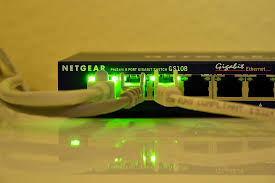Network switches can be “Unmanaged” or “Managed”. For most home or small business needs, an Unmanaged Gigabit switch is very adequate.
Contents
Recommended Network Switches:
What is a Network Switch?
A Network Switch is a thin metal box that has many Ethernet ports, and they are used to plug in more equipment into the Network using Ethernet cables.
Note that network performance using an Ethernet cable tends to be faster and more reliable than WiFi.
The current standard speed is Gigabit, meaning that each port can transfer 1Gb per second – provided that the port that the other end of the Ethernet cable is capable of connecting at 1Gb/ second. The previous generation of network switch technology-supported 100Mbps; in 2019, avoid getting 100Mbps network switches.
I like to have two link lights at every port; one flashes when there is activity on that port, and the other is an indication of speed. The speed color shows you whether the connected equipment has “trained” at 1Gbps (green color) or 100Mbps (amber color). Note that this link speed can also be used to help diagnose the quality of the connecting cable; if the Ethernet jack in both sides is rated at Gigabit, but the actual link speed shows 100Mbps – or if the DHCP configuration takes much longer than 1-5 seconds, then it is reasonable to suspect that the cable is either damaged (pinched too tightly by a staple, the cable was tightly bent, or the cable was driven over by a car or stepped on too many times by a person).
How do I figure out which Network Switch to get?
Make sure you get enough ports on your network switch. Sometimes you can have too many switches on a network. My rule of thumb is to get a switch that has at least double the number of ports that are being used right now or double the number of ports that are about to be installed, then round out (higher) to the higher port number interval. (eg: 4, 8, 16, 24, 32). For example, if you have a cheap and old 8 port network switch that has cables in every port, you will probably need to get another switch before you can add another piece of equipment. 1) get a good network switch, and 2) get one with “too many” ports. Networks tend to get bigger, not smaller; and sometimes network ports fail for a mystery reason, so it’s good to have some spares already on the switch readily available.
Do you have too many switches on a network?
Most DSL Modems come with 4 Ethernet ports on them. Cable Modems from the Cable company used to come with 4 Ethernet ports, but now come with just 2 Ethernet ports; they do this because most people are using WiFi more, and WiFi has become fast, and the WiFi card and antenna in those new cable modems tend to be good.
Recommendations:
Network switches can be “Unmanaged” or “Managed”. For most home or small business needs, an Unmanaged Gigabit switch is very adequate. Note that most of the recommended switches below have choices to get more or fewer ports. I think that 16 ports are a practical number of ports and practical cost when getting a network switch.
Please note: We will often recommend products, parts, and resources that we like. Sometimes we’ll receive an affiliate commission for at no additional cost to you. As an Amazon Associate, we earn from qualifying purchases.
Here are the specific switches that Chris recommends:
Gigabit network switches
8 Port Network Switches:
TP-Link 8 port Unmanaged.
Netgear 8-port Manageable
Netgear 8-port Manageable w/POE
Ubiquiti 8-port Manageable w/POE
16 Port Network Switches:
TP-Link 16 port Unmanaged.
Netgear 16 port Unmanaged.
Ubiquiti 16 port Manageable w/POE
24 Port Network Switches:
TP-Link 24 port Unmanaged.
TrendNet 24 port Unmanaged.
NETGEAR 24 port Un-managed
Netgear 24 port Unmanaged
Ubiquiti 24 port Unfi
Also:
Gigabit Media Converters (for when you need more distance than the 100M length limitation of a copper wire ethernet cable):
RJ45-to-Fiber (one)
10GTek RJ45-to-Fiber (two)
10GTek RJ45-to-Fiber (one)
Let us know if you need help installing and configuring your new Switch!